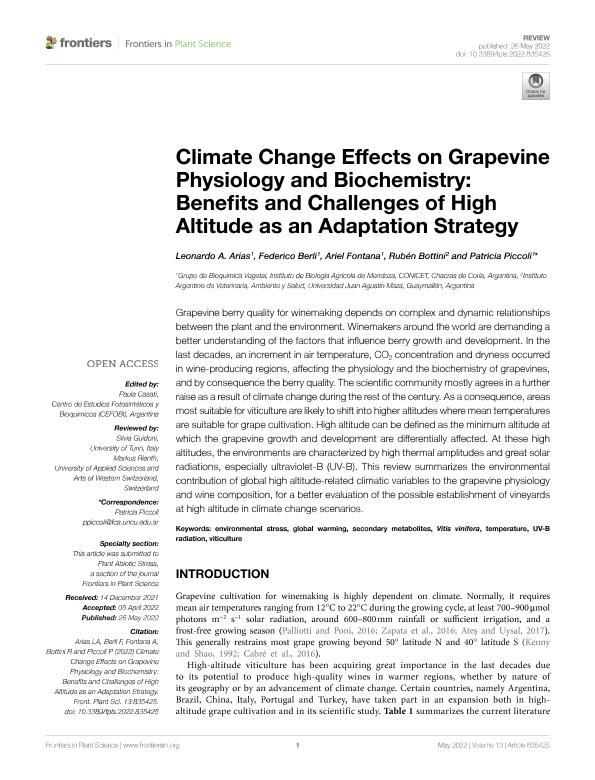Artículo
Climate change effects on grapevine physiology and biochemistry: Benefits and challenges of high altitude as an adaptation strategy
Arias, Leonardo Agustín ; Berli, Federico Javier
; Berli, Federico Javier ; Fontana, Ariel Ramón
; Fontana, Ariel Ramón ; Bottini, Ambrosio Ruben
; Bottini, Ambrosio Ruben ; Piccoli, Patricia Noemí
; Piccoli, Patricia Noemí
 ; Berli, Federico Javier
; Berli, Federico Javier ; Fontana, Ariel Ramón
; Fontana, Ariel Ramón ; Bottini, Ambrosio Ruben
; Bottini, Ambrosio Ruben ; Piccoli, Patricia Noemí
; Piccoli, Patricia Noemí
Fecha de publicación:
04/2022
Editorial:
Frontiers Media
Revista:
Frontiers in Plant Science
ISSN:
1664-462X
Idioma:
Inglés
Tipo de recurso:
Artículo publicado
Clasificación temática:
Resumen
Grapevine berry quality for winemaking depends on complex and dynamic relationships between the plant and the environment. Winemakers around the world are demanding a better understanding of the factors that influence berry growth and development. In the last decades, an increment in air temperature, CO2 concentration and dryness occurred in wine-producing regions, affecting the physiology and the biochemistry of grapevines, and by consequence the berry quality. The scientific community mostly agrees in a further raise as a result of climate change during the rest of the century. As a consequence, areas most suitable for viticulture are likely to shift into higher altitudes where mean temperatures are suitable for grape cultivation. High altitude can be defined as the minimum altitude at which the grapevine growth and development are differentially affected. At these high altitudes, the environments are characterized by high thermal amplitudes and great solar radiations, especially ultraviolet-B (UV-B). This review summarizes the environmental contribution of global high altitude-related climatic variables to the grapevine physiology and wine composition, for a better evaluation of the possible establishment of vineyards at high altitude in climate change scenarios.
Archivos asociados
Licencia
Identificadores
Colecciones
Articulos(IBAM)
Articulos de INST.DE BIOLOGIA AGRICOLA DE MENDOZA
Articulos de INST.DE BIOLOGIA AGRICOLA DE MENDOZA
Citación
Arias, Leonardo Agustín; Berli, Federico Javier; Fontana, Ariel Ramón; Bottini, Ambrosio Ruben; Piccoli, Patricia Noemí; Climate change effects on grapevine physiology and biochemistry: Benefits and challenges of high altitude as an adaptation strategy; Frontiers Media; Frontiers in Plant Science; 13; 8354; 4-2022; 1-14
Compartir
Altmétricas



